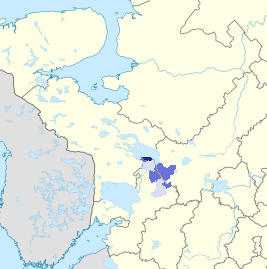
The Tibetan script is a segmental writing system (abugida) of Indic origin used to write certain Tibetic languages, including Tibetan, Dzongkha, Sikkimese, Ladakhi, Jirel and Balti. It has also been used for some non-Tibetic languages in close cultural contact with Tibet, such as Thakali. The printed form is called uchen script while the hand-written cursive form used in everyday writing is called umê script. This writing system is used across the Himalayas, and Tibet.

Veps, also known as Vepsian, is a Finnic language from the Uralic language family, that is spoken by Vepsians. The language is written in the Latin script, and is closely related to Finnish and Karelian.
Historical Chinese phonology deals with reconstructing the sounds of Chinese from the past. As Chinese is written with logographic characters, not alphabetic or syllabary, the methods employed in Historical Chinese phonology differ considerably from those employed in, for example, Indo-European linguistics; reconstruction is more difficult because, unlike Indo-European languages, no phonetic spellings were used.

The Erzya language, also Erzian or historically Arisa, is spoken by approximately 300,000 people in the northern, eastern and north-western parts of the Republic of Mordovia and adjacent regions of Nizhny Novgorod, Chuvashia, Penza, Samara, Saratov, Orenburg, Ulyanovsk, Tatarstan and Bashkortostan in Russia. A diaspora can also be found in Armenia and Estonia, as well as in Kazakhstan and other states of Central Asia. Erzya is currently written using Cyrillic with no modifications to the variant used by the Russian language. In Mordovia, Erzya is co-official with Moksha and Russian.

The Marshallese language, also known as Ebon, is a Micronesian language spoken in the Marshall Islands. Spoken by the ethnic Marshallese people, the language is spoken by nearly the country's entire population of 59,000, making it the principal language of the country. There are also roughly 27,000 Marshallese citizens residing in the United States, nearly all of whom speak Marshallese, as well as in other countries including Nauru.
Consonant mutation is change in a consonant in a word according to its morphological or syntactic environment.
Neo-Mandaic, sometimes called the "ratna", is the modern reflex of the Mandaic language, the liturgical language of the Mandaean religious community of Iraq and Iran. Although severely endangered, it survives today as the first language of a small number of Mandaeans in Iran and in the Mandaean diaspora. All Neo-Mandaic speakers are multilingual in the languages of their neighbors, Arabic and Persian, and the influence of these languages upon the grammar of Neo-Mandaic is considerable, particularly in the lexicon and the morphology of the noun. Nevertheless, Neo-Mandaic is more conservative even in these regards than most other Neo-Aramaic languages.

Skolt Sámi is a Uralic, Sámi language that is spoken by the Skolts, with approximately 300 speakers in Finland, mainly in Sevettijärvi and approximately 20–30 speakers of the Njuõʹttjäuʹrr (Notozero) dialect in an area surrounding Lake Lovozero in Russia. Skolt Sámi also used to be spoken in the Neiden area of Norway. It is written using a modified Roman orthography which was made official in 1973.

Kwakʼwala, or Kwak̓wala, previously known as Kwakiutl, is the Indigenous language spoken by the Kwakwakaʼwakw in Western Canada. Kwakʼwala belongs to the Wakashan language family. There are fewer than 200 fluent Kwakʼwala speakers today, which amounts to 3% of the Kwakwakaʼwakw population. Because of the small number of speakers, most of whom are elders, as well as the fact that very few if any children learn Kwakʼwala as a first language, its long-term viability is in question. However, interest from many Kwakwakaʼwakw in preserving their language and a number of revitalization projects are countervailing pressures which may extend the viability of the language.
This article deals with the phonology of the standard Ukrainian language.

Lepcha language, or Róng language, is a Himalayish language spoken by the Lepcha people in Sikkim, India and parts of West Bengal, Nepal and Bhutan.
The Sikkimese language, also called Sikkimese, Bhutia, or Drenjongké, Dranjoke, Denjongka, Denzongpeke and Denzongke, belongs to the Tibeto-Burman languages. It is spoken by the Bhutia in Sikkim, India and in parts of Province No. 1, Nepal. The Sikkimese people refer to their own language as Drendzongké and their homeland as Drendzong. Up until 1975 Sikkimese was not a written language. After gaining Indian Statehood the language was introduced as a school subject in Sikkim and the written language was developed.
Classical Tibetan refers to the language of any text written in Tibetic after the Old Tibetan period. Though it extends from the 12th century until the modern day, it particularly refers to the language of early canonical texts translated from other languages, especially Sanskrit. The phonology implied by Classical Tibetan orthography is very similar to the phonology of Old Tibetan, but the grammar varies greatly depending on period and geographic origin of the author. Such variation is an under-researched topic.
The most thorough treatment of the Kiowa sound system is by Laurel Watkins in a generative framework. A consideration of prosodic phenomena with acoustic analysis is in Sivertsen (1956). Earlier discussions of phonemics are Trager (1960), Merrifield (1959), Wonderly et al. (1954), and Harrington (1928).
Serbo-Croatian is a South Slavic language with four national standards. The Eastern Herzegovinian Neo-Shtokavian dialect forms the basis for Bosnian, Croatian, Montenegrin, and Serbian.
Hiw is an Oceanic language spoken on the island of Hiw, in the Torres Islands of Vanuatu. With about 280 speakers, Hiw is considered endangered.

The small group of Hachijō dialects, natively called shima kotoba, depending on classification, are either the most divergent form of Japanese, or comprise a branch of Japonic. Hachijō is currently spoken on two of the Izu Islands south of Tokyo as well as on the Daitō Islands of Okinawa Prefecture, which were settled from Hachijō-jima in the Meiji period. It was also previously spoken on the island of Hachijō-kojima, which is now abandoned. Based on the criterion of mutual intelligibility, Hachijō may be considered a distinct Japonic language, rather than a dialect of Japanese.

Proto-Slavic is the unattested, reconstructed proto-language of all Slavic languages. It represents Slavic speech approximately from the 2nd millennium B.C. through the 6th century A.D. As with most other proto-languages, no attested writings have been found; scholars have reconstructed the language by applying the comparative method to all the attested Slavic languages and by taking into account other Indo-European languages.
This article describes the grammar of the Old Irish language. The grammar of the language has been described with exhaustive detail by various authors, including Thurneysen, Binchy and Bergin, McCone, O'Connell, Stifter, among many others.
Romance linguistics is the study of linguistics of Romance languages.









